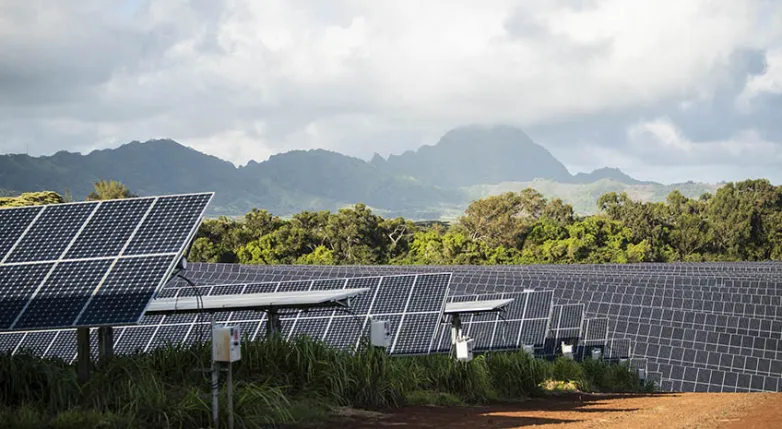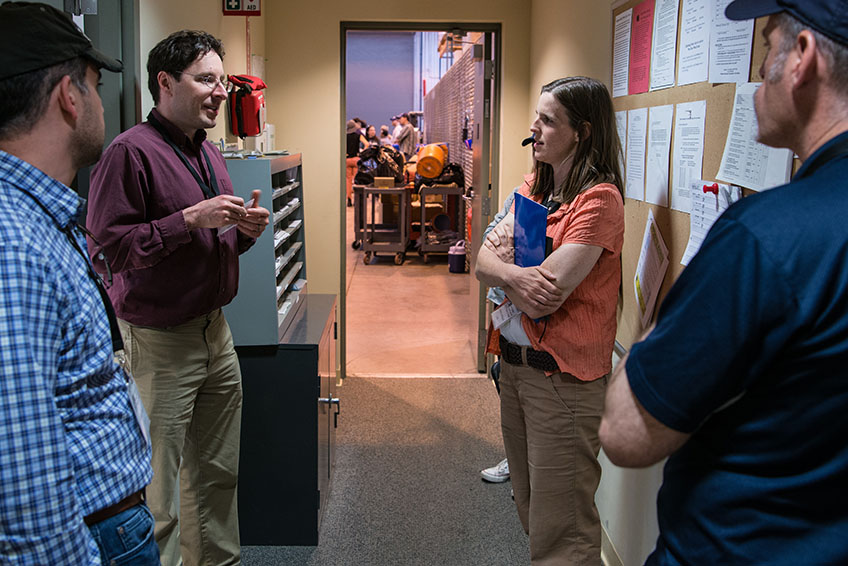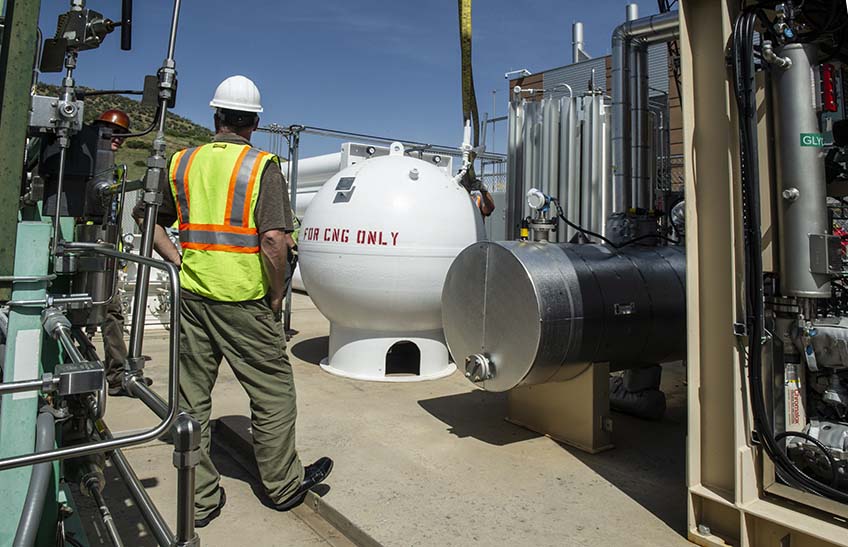Declining Renewable Costs Drive Focus on Energy Storage
- Declining costs in available technologies have propelled interest in energy storage forward like never before. The price of lithium-ion batteries has fallen by about 80% over the past five years, enabling the integration of storage into solar power systems.

An oft-repeated refrain—the sun doesn’t always shine, and the wind doesn’t always blow—is sometimes seen as an impediment to renewable energy. But it’s also an impetus toward discovering the best ways to store that energy until it’s needed.
Declining costs in available technologies have propelled interest in energy storage forward like never before. The price of lithium-ion batteries has fallen by about 80% over the past five years, enabling the integration of storage into solar power systems. Today, nearly 18% of all electricity produced in the United States comes from renewable energy sources, such as hydropower and wind—a figure that is forecast to climb. And as communities and entire states push toward higher percentages of power from renewables, there’s no doubt storage will play an important role.
Compared with the same period a year earlier, the United States saw a 93% increase in the amount of storage deployed in the third quarter of 2019. By 2024, that number is expected to top 5.4 gigawatts, according to a forecast by market research firm Wood Mackenzie Power & Renewables. The market value is forecast to increase from $720 million today to $5.1 billion in 2024. Driving such growth is an increased focus on adding renewable energy sources to the nation’s grid.
Only in the past decade has the widespread adoption of renewable energy sources become an economic possibility, said Paul Denholm, a principal energy analyst at the National Renewable Energy Laboratory (NREL). He joined NREL 15 years ago and, at the time, he and other analysts were busy plotting a path to 20% of the nation’s energy supply coming from renewable sources. Now, they’re aiming much higher.
“The declining cost of wind and solar and now batteries makes it conceivable to consider 100% renewables,” he said.
NREL’s Renewable Electricity Futures Study estimated that 120 gigawatts of storage would be needed across the continental United States by 2050, when the scenario imagined a future where 80% of electricity will come from renewable resources. The country currently has 22 gigawatts of storage from pumped hydropower, and another gigawatt in batteries.

NREL’s Paul Denholm (second from left) talks to stakeholders during a tour of renewable energy and transmission facilities in Los Angeles, where a solar facility will play a key role in increasing the amount of renewable energy available for the city. Photo by Dennis Schroeder, NREL
Deployment of Storage a Must in Hawaii
Hawaii, which must import all of its fossil fuels and pays a high price for electricity as a result, is experimenting with using battery storage to meet its energy goals. The state is aiming for 100% clean energy by 2045, using both renewable energy and improved energy efficiency. The AES Corporation, based in Virginia, has installed the world’s largest solar-plus-storage system on the southern end of Kauai.
Solar panels capable of producing 28 megawatts of electricity were paired with 18,304 lithium-ion battery modules. The batteries are charged during the day and deliver energy in the early morning and evening when the solar panels aren’t generating electricity.
The system stores enough energy to meet electricity needs for four hours and eliminates the need for 3.7 million gallons of fuel annually, according to Kauai Island Utility Cooperative, which provides power to the island. Kauai now generates about 55% of its energy via photovoltaic (PV) systems.
NREL researchers tested how well this PV-storage system would work by installing and evaluating a scaled-down version at its Flatirons Campus.
“You can see simulations and you can see some graphs. It’s nothing as convincing as seeing a utility-size device operating,” said Przemek Koralewicz, principal investigator on the testing project. “This gives you a lot of confidence.”
A second AES PV-plus-storage plant now under construction at the Navy base on Kauai will provide electricity to customers as needed but also serve as an isolated microgrid for the military should power be interrupted. When the new plant becomes operational next year, about 60% of electricity on Kauai will come from renewables.
“These two plants from AES can supply half the power for the entire island,” Koralewicz said. “During the night, they can provide full power, in certain scenarios. That’s why it’s important to test it. AES doesn’t want it to be unstable or have problems.”
Battery storage provides a way to keep the grid stable, allowing an instant balance between supply and demand. Storage also is poised to replace conventional energy generation during peak demands, eliminating the need for additional plants, but limitations hamper the use of batteries. A power plant can remain operational for decades, but a battery must be replaced after about a dozen years. Batteries also suffer from a limited capacity, which means they typically only can store enough energy to provide power for four hours.
Cost of Storage Isn’t Easy to Quantify
Pinning down the cost of storage remains elusive. A frequently used metric called levelized cost of energy (LCOE) allows a comparison of the cost to generate electricity by different means. But the LCOE is only accurate when the differing technologies provide the same services.
A group of NREL researchers, including David Feldman and Robert Margolis, developed an LCOE for solar plus storage. “Like all LCOEs, it has its limitations in use,” Feldman said. “One of the challenges, particularly for storage, is that there are so many different use cases that cost doesn’t mean much unless you are defining the value that the system brings.”
Using storage can save a utility money by reducing the need to generate electricity and avoiding transmission costs.
An NREL-authored paper published last year in The Electricity Journal found solar-plus-storage reduced utility costs for commercial buildings in more than half of the 17 cities examined, in some cases by as much as 24%. Using batteries for storage, the properties were able to offset a utility’s rates that require users to pay more during times of peak demand.
Peaking power plants, fueled by natural gas and switched on to help meet peak demand, run into cost comparisons against batteries capable of storing four hours of energy. For that duration, the balance tips in favor of batteries. Beyond four hours, though, the battery becomes more expensive.
“The reason why we have so many peaking plants is air conditioning,” said Denholm. “That’s when we use the most electricity. One thing you can do is instead of building a bunch of power plants that only run 100 hours a year when it’s really hot, you can store cold energy in the form of ice or something. Make ice at 4 in the morning and then, when it gets hot in the middle of the afternoon, you can release that cold stored energy and cool down your house or your building.”
Technologies Encompass a Wide Range
“There’s a misunderstanding. Storage is often looked upon as electrochemical storage or battery storage,” said Adarsh Nagarajan, the group manager for Power System Design and Planning at NREL and who works extensively on integrating renewables onto the grid. “Storage is beyond batteries. It’s beyond electrochemical. It’s much broader.”
The Department of Energy (DOE) Global Energy Storage Database counts nearly 700 storage projects announced, operational, or under construction across the United States that rely on myriad technologies. In addition to batteries, the storage methods include ice, pumped hydropower, heat, chilled water, and electrochemical. Still other technologies are under development.
“There is no one winner,” Nagarajan said. “All of them should work together in order to achieve a certain goal, which is grid stability and resilience and to fulfill customer needs.”
But even with so many ways to store energy already available, new or improved technologies are constantly being proposed. Researchers at NREL developed a technique to inject natural gas into depleted wells, patented a method for storing pressurized hydrogen inside specially designed wind turbines, and improved the design of lithium-ion batteries to make them last longer.
Clear favorites have emerged among storage technologies already in use. The DOE Energy Storage Technology and Cost Characterization ReportPDF calculated that among battery technologies, lithium-ion batteries provide the best option for four-hour storage in terms of cost, performance, and maturity of the technology. For a longer span, pumped-storage hydropower and compressed-air energy storage are considered the best options. Between those two, pumped-storage hydro is the more mature technology and accounted for 98 percent of worldwide energy storage deployed in 2018.
Water Most Commonly Used in Storage
Pumped storage hydropower is the backbone of the nation’s storage capability. Historically, it was used to incorporate large, inflexible generation onto the power system. Currently, pumped storage is being used to help integrate large amounts of renewable energy onto the grid, serving as an enabling technology that both improves reliability and reduces costs. Pumped storage hydro relies on two reservoirs sited at different elevations. Electricity that’s been generated but not immediately needed is used to pump water from the lower reservoir to the upper one. When power is needed, the stored water is released to flow downhill and power a turbine.
“One of the real challenges hydro faces is that it can take eight to 10 years to get a plant built,” said Greg Stark, the hydropower technical manager at NREL as well as the laboratory’s waterpower grid integration lead. “Given all the uncertainty in the power markets, people are hesitant to invest in a 10-year project.”
To help address these time-to-market concerns, the DOE has instituted the FAST Commissioning Challenge. Tessa Greco, NREL’s new water power innovative projects manager, is leading the competition for the department’s Water Power Technologies Office, with the goal being to cut project execution time in half while also reducing the costs and risks associated with bringing pumped storage online. The Federal Energy Regulatory Commission has also recognized these challenges and has ordered that licensing decisions for closed-loop pumped storage projects be made within two years. So far, this type of system—which isn’t connected to an existing body of water and thereby reduces environmental concerns—has yet to be built in the United States.
Several projects are in process, including the Gordon Butte project in Montana. The Gordon Butte system, which has been permitted and is expected to begin construction this year, will use two man-made reservoirs and three turbines to provide 400 MW of capacity and 8.5 hours of storage. Pumped storage has historically required a unique design and build strategy for every new project; however, the Gordon Butte project presents a replicable model, which could save money for potential developers.
“Pumped storage really comes into its own when you need very large amounts of power for an extended period of time,” Stark said. “Part of that is because the incremental cost to increase the duration for pumped storage is just building a bigger reservoir. It’s still the same turbines and other infrastructure, whereas with battery storage for example, if you want longer duration, you have to buy more batteries.”
Seasonal Storage Requires Careful Study
Long-term energy storage is roughly defined as from 10–100 hours. Anything over that is considered seasonal. Wind blows more in the spring, so being able to capture that energy until it can be used when needed in the summer creates research opportunities. Hydrogen, hydropower, and compressed air are the most viable technologies for storing energy over lengthy periods, according to Omar Guerra and Josh Eichman, researchers at NREL studying the value of seasonal energy storage technologies.
Working in partnership with Southern California Gas Company, NREL installed a bioreactor to test power-to-gas technology as a way to store renewable energy. The project, a first in the United States, relies on microorganisms that convert hydrogen and carbon dioxide into methane. The methane can be stored in the company’s pipeline for use later.

Crews install a natural gas storage vessel next to the bioreactor outside the Energy Systems Integration Facility at NREL. It will store the renewable methane produced from the Southern California Gas bioreactor. Photo by Dennis Schroeder, NREL
The network of natural gas pipelines across the United States runs for about 3 million miles and already is used as a storage vehicle. “It’s moving the gas, but it’s also a way to store it,” said Keith Wipke, manager of NREL’s Fuel Cell and Hydrogen Technologies program.
Hydrogen can be added to the natural gas pipeline—as much as about 10%—or stored separately. One method to store hydrogen that’s been proposed—but has yet to be widely adopted—is carving out space within salt caverns, Wipke said.
Storing natural gas helps hedge against price fluctuations and meet seasonal demands, but the cost of the equipment has stalled the adoption of seasonal electricity storage. Hydrogen storage remains an emerging technology, but as research leads to improvements it’s expected to eventually be the most cost-effective method for keeping and discharging at least a week’s worth of electricity, Guerra said. Pumped hydropower and compressed air storage of as long as two days are forecast to be cost-competitive with generating new electricity.
“Pumped hydro and compressed-air energy storage are well-developed technologies, so we don’t expect a significant decline in those capital costs,” Guerra said. “Those costs also may depend on the location. In some places you may have an opportunity to develop pumped hydro in a cost-effective way. In other places you may have the opportunity for compressed-air energy storage.”
“We need to drive the cost down on the technologies we have today, and certainly some new technologies that are better and cheaper would be good,” Wipke said.
Zhiwen Ma is working on just that. The researcher works in NREL’s Thermal Systems Group and focuses his efforts on concentrating solar power, or CSP. The technology uses a series of mirrors or lenses to concentrate sunlight onto a small area, and the energy captured can be stored in molten salt. But the salts are corrosive, so research is ongoing to the ideal containment vessel. Instead of salt, Ma is using sand to store the heat.
DOE’s Advanced Research Projects Agency-Energy, which funds futuristic ideas, has awarded NREL $2.8 million to investigate the feasibility of Ma’s low-cost thermal energy storage system. When needed, the heated sand will heat a fluid that drives a gas turbine attached to a generator.
“The main advantages over molten salt are the low cost and performance,” Ma said. The sand is a fraction of the cost of the salt but can be heated to 1,200 degrees Centigrade compared to 600 degrees for nitrate salt or 800 degrees for chloride salt.
With so many options to store energy, researchers are determined to find the best methods. After all, the sun doesn’t always shine, and the wind doesn’t always blow.
Also read
- Engie, NHOA Plug 320-MWh Battery Near Brussels
- India’s record-low storage bids spark viability and safety concerns
- Solar output overtakes coal in Texas, marking historic power shift
- Agile Energy Secures Equity for 200MW Australian Solar-Plus-Storage
- Vena Energy Starts Building 408-MWh Battery in South Australia

